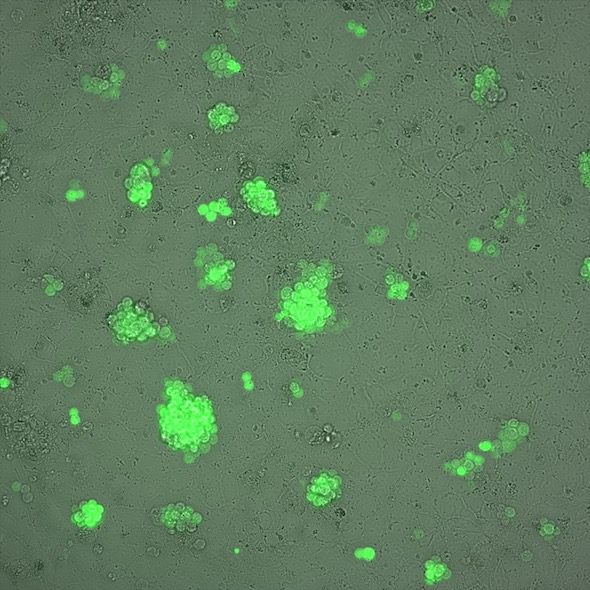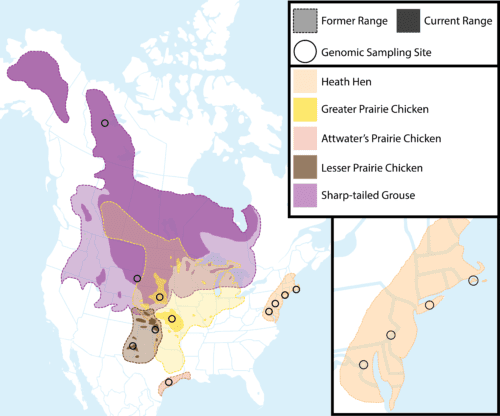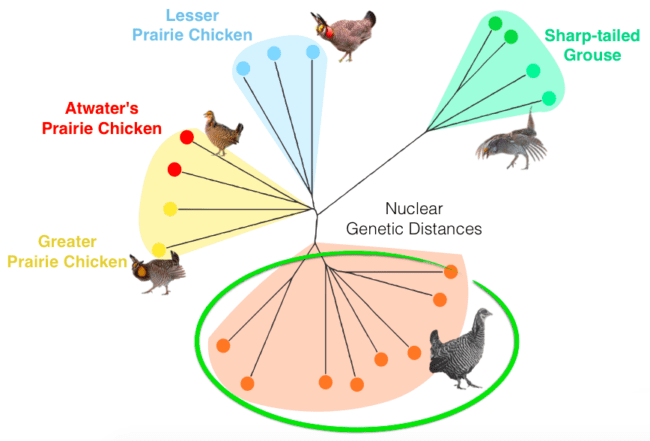PROGRESS TO DATE
A bottleneck for all avian genetic rescue projects is a lack of advanced reproductive techniques that are compatible with the unique reproductive biology of birds. With the Heath Hen de-extinction project, we are working to develop the foundational science that is essential for reviving the extinct Heath Hen species as well as all avian species. The development of these tools has the potential to help enhance genetic diversity, build disease resistance, develop synthetic alternatives, and facilitate adaptation to a changing climate.
April 2020: Greater Prairie Chickens at Texas A&M
The Walzem Lab at Texas A&M University reports that the greater prairie chickens are adapting well to their enclosure. The males are demonstrating their trademark “booming” call and the hens are showing potential to lay eggs. Meanwhile, researchers continue to fine-tune the materials and techniques needed for avian genetic rescue. For one, the lab is currently testing the ability for size exclusion technology to reduce the unintended culture of non-PGC cell types and improve the isolation of primordial germ cells (PGCs).
In the video at right, while a hen looks on, a male greater prairie chicken stomps and lets out its trademark boom, much like that of its notably noisy relative, the extinct heath hen. (From TAMU student Wyatt Sandhop).
2019: In Vitro Research Continues
The key milestone of Phase Two is successfully culturing the primordial germ cells (PGCs) of the greater prairie chicken, the proximate species to the Heath Hen. Initial phase two lab work was paused in early 2017 after our avian genetics partner Crystal Bioscience was acquired and could no longer work on our project. With bench-work paused, Revive & Restore leveraged the initial Heath Hen de-extinction work into an avian genetic rescue program, secured a new academic partner, and raised the necessary funding to proceed with the first key milestone. Meanwhile alternative protocols for germ-line transmission were explored with international partners (see 2018 below).
Revive & Restore’s recently established Catalyst Fund Program awarded a two-year grant to Dr. Rosemary Walzem of Texas A&M University to develop and optimize techniques to enable germline transmission of primordial germ cells for avian genetic rescue applications, using the greater prairie chicken as the model species. This avian genetic rescue program will not only build upon the work of Crystal Bioscience, but also serve as a model for other avian species. The goal is to jump start additional avian genetic projects around the world that will advance biotechnologies for a wide range of endangered and extinct birds.
2018: An Alternative Pathway for Obtaining Primordial Germ Cells
In 2018, in order to capitalize upon the partial success of Crystal Bioscience, Revive & Restore shipped the late-stage germ-cell cultures established in 2016 to Dr. Benjamin Schusser’s lab at the Technische Universität München, in Munich Germany. Schusser’s lab will conduct germ-line transfer experiments in adult male domestic chickens, as opposed to the standard embryonic implantation method using primordial-stage germ cells. Dr. Schusser’s lab is currently running control experiments with domestic chickens, and experiments using greater prairie chicken germ-cells will follow. If successful, Crystal Biosciences’ cell cultures may yet produce the world’s first greater prairie chickens hatched using biotechnology. The ability to salvage late-stage germ cells and use adult chimeric hosts opens up a wider array of opportunities to apply genetic rescue to rare birds.
2016 – 2017: Phase Two Research with Crystal Bioscience
For the revival of the Heath Hen, gene-edited cells that can develop into live chicks are needed. This will be accomplished by using a process known as germ-line transmission, where the primordial germ cells (PGCs) of an early embryo are gene-edited, grown in culture, and then reproductively transmitted through surrogate host parents to generate live, engineered birds.
This technology is routinely used in domestic chickens but is not yet a viable reproductive technique for wild species. Using eggs produced by a flock of greater prairie chickens housed at Grouse Park, Crystal Bioscience researchers were able to establish five viable cell lines from a series of experimental culture conditions. Early in vitro analyses of gene expression revealed that the cell lines were germ-cells, the target cell type. Later in vivo experiments, however, revealed the cells to be late-stage germ-cells, not primordial, and therefore incompatible with current germ-line transmission techniques.
Pictured right: The world’s first genetically engineered Greater Prairie Chicken cells. An inserted GFP marker gene causes them to fluoresce.

Despite this seemingly disappointing news, this initial research accomplished major milestones:
- Development of standard operating procedures for working with greater prairie chicken eggs and embryos—from aviary to laboratory
- Identification of the necessary growth factors and culture medium needed to keep greater prairie chicken germ cells alive in culture
- These growth factors work well with late-stage germ cells, and after some minor adjustments, will likely work well with earlier stage germ cells
2014: Results of Heath Hen Genomic Study
The goal of Phase One was to supply the data necessary to understand the relevant taxonomic and genetic differences between the Heath Hen and its living relatives. In 2014, Revive & Restore sequenced the genomes of the Heath Hen and all three living species in its genus, Tympanuchus: the greater prairie chicken (T. cupido pinnatus) and its subspecies the Attwater’s prairie chicken (T. c. attwateri); the lesser prairie chicken (T. pallidicinctus), and two subspecies of Sharp-tailed Grouse, (T. phasianellus kennicoti) and (T. phasianellus jamesi). A total of 19 genomes were sequenced to decipher the taxonomic relationship of the Heath Hen to its living relatives.
Dovetail Genomics created a reference genome using the greater prairie chicken, which was the basis of subsequent genomic analysis. Our high quality reference genome of the greater prairie chicken is now available on the National Center for Biotechnology Information’s public GenBank database.
What did we learn?
Once thought to be a subspecies of greater prairie chicken, the Heath Hen’s genome reveals that it is distinct from its relatives, meaning that gene-editing is the only way to revive its unique traits. This result gave the green light for Phase 2 of Heath Hen de-extinction to begin.
Dr. Jeff Johnson analyzed the genomes of the entire grouse family tree using whole genome data, but definitive and reproducible results have remained elusive. While the initial finding that the Heath Hen is a unique species remains unchanged, interbreeding between the other living species obscures the genus’ relationships, making the eco-evolutionary insights necessary for de-extinction difficult to discover. More specimens are currently being sequenced to help overcome the mixed genomic signals. In the meantime, Dr. Giri Athrey of Texas A&M University is using this unique data set to study the evolution of gene families among birds, particularly immune genes, which have shown to be key to conservation success for the critically endangered Attwater’s prairie chicken.
The field of genomics is ever improving and elevating standards of genome assembly. The ultimate goal is to assemble genomes to their original chromosomal configuration. Dr. Erez Aiden and Dr. Olga Dudchenko of the Center for Genome Architecture worked with Revive & Restore to improve the Dovetail Genomics’ reference assembly to a chromosomal level, an assembly currently available at the Aiden lab’s DNA Zoo project. This chromosomal level reference genome will enable a new level of analysis of the association of genes on different chromosomes, recombination landscapes, and the distribution of diversity across the genome. This tertiary information may reveal key insights into how Heath Hens were able to thrive in fragmented populations that a simple reading of the DNA sequence could not reveal, and could therefore provide essential information for revival.





